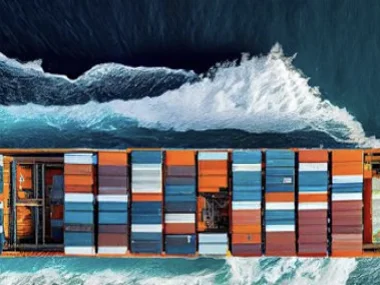How high are logistics costs in Vietnam? 3
Domestic logistics costs account for a large proportion of the price of goods. This has eroded Vietnamese export enterprises' profits and caused them to lose their competitive advantage compared to enterprises in other countries in the region.
North-South freight rates are even higher than those to the US
A representative of a retailer that once brought Vietnamese mangoes to supermarket chains in Japan said that the quality of Vietnamese mangoes is equivalent to that of Thai and Philippine mangoes, but when brought to the retail system in Japan, the price of a Vietnamese mango is nearly 20% more expensive than that of Thai and Philippine mangoes. Therefore, the amount of Vietnamese mangoes exported and consumed in Japan is not high.

Logistics costs are eroding profits, reducing the competitive advantage of Vietnamese goods
The above story is not new. In export, Vietnamese goods are bearing too many logistics costs such as domestic freight rates, fees and surcharges collected by foreign shipping lines higher than the prescribed level... This makes Vietnamese export goods that are already in a difficult position even more difficult. Ms. Nguyen Anh, representative of a foreign logistics company in Ho Chi Minh City, said that compared to this time last year, the "booking" fee for ships from abroad has not changed, but the fee for booking foreign ship services from within the country has increased by 10%. In addition, domestic freight rates up to the end of June this year are still quite high, pushing up the cost of export goods.
Specifically, domestic freight rates increased by about 15 - 20% compared to the same period last year. Domestic container trucks, transporting goods from the factory to the port or vice versa, within a radius of 100 km, the freight rate was at its lowest level of about 2.2 million VND a year ago, but has now increased to 2.5 - 2.6 million VND. However, Ms. Nguyen Anh also added that due to the sharp decrease in export orders, the number of customers "booking" ships at the company has decreased by about 60% compared to last year. Not only domestic freight rates, but also the container lifting/lowering fee, instead of 30 USD/container, has now increased to 45 USD. Ms. Nguyen Anh said: "The high container lifting/lowering fee collected by shipping lines is contributing to higher import and export goods costs".
It is worth mentioning that at this time last year, the domestic gasoline price was 33,000 VND/liter, but this year it has dropped to 22,000 VND/liter. Mr. Nguyen Ly Truong An, an import-export expert and Deputy Director of SeaAir Global Company, commented that freight rates decreased slightly at the end of the year and then increased immediately afterwards. "Regardless of the sharp decrease in gasoline prices, transportation companies that have increased their prices will never decrease them following gasoline prices," Mr. An said, adding: Currently, the shipping cost for a container of goods from a port in Vietnam to the East Coast of the United States is about 2,300 USD, and from Vietnam to the West Coast of the United States is about 2,000 USD.

Meanwhile, a container of goods transported from the North to the South, the transport unit quoted a price of 55 million VND (equivalent to about 2,300 USD). "If including value added tax, this fee increases to more than 2,600 USD, higher than the fee of 1 container of goods exported to the US. Too strange. Recently, I also consulted about transporting goods by rail, the price is much cheaper, but the problem is that the security of the goods is not guaranteed. In addition, the routes are not flexible, so export goods still depend mainly on domestic transport by waterway or road, railways only transport small goods", said Mr. Nguyen Ly Truong An.
Big "barrier" for export goods
According to some statistics of wooden furniture export enterprises, the general logistics cost "hit" on 1 container of exported wood accounts for 20 - 30% of the total value of the shipment. For example, a shipment worth 20,000 - 30,000 USD will incur logistics costs of up to 4,000 - 9,000 USD. Logistics costs for Vietnamese textiles and garments are currently 6% higher than Thailand, 7% higher than China, 12% higher than Malaysia and 3 times higher than Singapore.
Data from the Vietnam Logistics Services Association (VLA) also shows that logistics costs compared to Vietnam's gross domestic product (GDP) are at 16.8%, while the world average is 10.7%. If calculated within the ASEAN region, Vietnam's logistics costs are higher than those of Singapore (at 8.5%), Malaysia (13%) and Thailand (15.5%). Chairman of the Vietnam Textile and Apparel Association, Mr. Vu Duc Giang, commented that in the context of textile and garment exports being too difficult, Vietnam's higher logistics costs make it difficult for businesses to compete with goods exported from countries in the region and erode all profits, and also become an obstacle for businesses when penetrating new markets, especially during this time when many export enterprises are trying to find new markets.
Sharing the same view, import-export expert Nguyen Ly Truong An said that many export enterprises said they find it difficult to compete on price when looking for ways to expand the market during difficult times, especially for garments, leather and footwear, etc. He analyzed: High domestic freight rates will lead to two trends: increased export prices, reducing the competitive position of goods from Vietnam; Vietnamese exporters will choose EXW terms (delivery at the factory or ex-factory price) instead of FOB (price loaded on board at the port) to avoid domestic freight rates. But if we do so, businesses will lose a lot of profit, and at the same time, goods will lose their "home market" position.
"In difficult times, it is hard to accept that orders are "falling" like figs everywhere, but costs are increasing. The structure to create domestic freight rates currently includes road and bridge costs of all kinds; high gasoline prices and other costs arising when goods are transported to the provinces. If the cause is determined from these 3 types of costs, export support will be based on that. In my opinion, gasoline prices have dropped sharply, and transportation businesses need to return freight rates to reality. Next, we need to review all types of road and bridge fees to see which areas are unreasonable, which other costs are causing difficulties for businesses, and need to be eliminated immediately," Mr. An emphasized.







